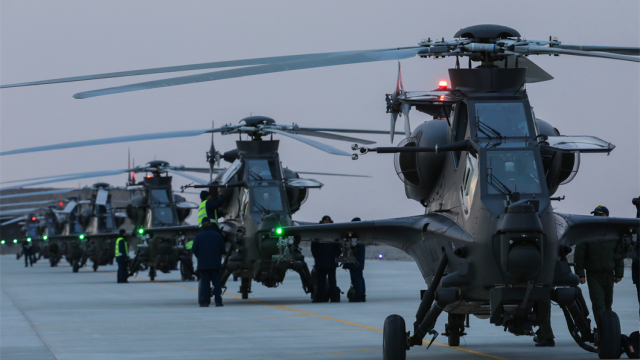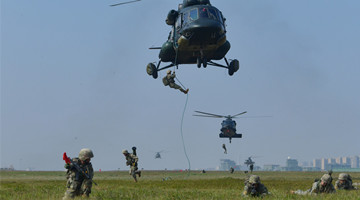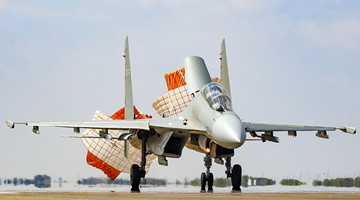By Zhang Xiaotian, Xu Zhidong, Zhang Weiping
The year 2020 is coming to an end amid the rampant COVID-19 pandemic and ceaseless conflicts. As we look back on the past year, we see the novel coronavirus wreaking havoc across the world, major-country competition continuously escalating, the world situation being adjusted at a faster pace, regional hotspots popping up one after another, and all-terrain security risks on the rise. 2020 is a year when the old international order is falling apart more quickly, and the new landscape is being shaped with twists and turns. It marks the beginning of deep-going turbulences and changes in international military conflicts and security situation.
Adjustments of major countries' strategic layouts
Historical laws tell us that the international system never evolves in a linear trajectory, nor does the rise and fall of powers, it is always a process of quantitative and qualitative accumulation, emergence, escalation, and restructuring.
The widespread COVID-19 in 2020 is nothing short of a war, which, though unable to comprehensively overthrow the world situation, is an important game-changer. Throwing its weight around throughout the year, the epidemic has again demonstrated the non-linear evolution of human society and world landscape and accelerated the development.
With the epidemic still running amuck, the strength distribution of major nations, world security and development situation, and the way of international struggles are undergoing profound changes. In a strategic environment with mounting uncertainties, major countries like the US and Russia have actively made deployments to gain an edge.
Taking China and Russia as strategic adversaries, the Trump administration, guided by its "America first" policy and following such strategic plans as the US National Defense Strategy and Indo-Pacific Strategy, has accelerated its movements to promote a "whole-of-government strategy on China".
First, the US has intensified its ties with Taiwan region and pressed China harder at its doorstep. In March, Trump signed off on the so-called "TAIPEI ACT", which claimed that "the US government should consider increasing or decreasing its economic, security, and diplomatic engagement with nations according to their relations with Taiwan". In July, the US Senate in the National Defense Authorization Act for Fiscal Year 2021 suggested "inviting Taiwan to participate in the RIMPAC military exercise and berthing American medical ships on the island". Regardless of warnings from Beijing, Washington passed bills on arms sales to Taiwan six times in 2020 that amounted to a total worth of more than $5.8 billion.
Second, the US has stepped up military operations in the South China Sea, China's maritime gateway to the south. In the first half of this year, American military aircraft operated more than 2,000 times in the region; in July, its dual-carrier formation held training and exercises there twice. These operations showed signs of shifting from close-in reconnaissance to provocation, pressuring, and combat exercises.
Third, the US has intensified cooperation with its allies and partners to forge an "anti-China alliance". In November, the US, Japan, Australia, and India held a joint military exercise that stressed more on joint operation than security cooperation. The US and its allies regularly monitored China's military activities in far oceans and enhanced their military presence around China and in the entire Indo-Pacific region. On November 17, the US secretary of the navy called for the reactivation of the 1st Fleet closer to the border between the Indian and Pacific Oceans. In the meantime, the US has acted faster to reduce and withdraw troops from other regions worldwide, and the troops, claimed the US Department of Defense, "will be redirected to engage in major-power strategic competition and maintain a strategic advantage".
While cementing its regional influence, Russia has made active deployments in interested regions and taken new steps during the pandemic.
First, it has built military bases in Africa. In August, it was reported that Russia expected to build six military bases in Africa. In November, Russia and Sudan signed an agreement to build military bases in the latter, the first time that Moscow had a military base in Africa after the disintegration of the Soviet Union, marking a significant step on its way to becoming a world power again.
Second, it has turned the table in Syria. In 2020, Russia continued to keep a military presence in Syria to support the Bashar al-Assad regime, defeat the US, Israel, and Turkey's attempts there, and fortify its influence in the Middle East.
Third, it has agilely mediated in the Nagorno-Karabakh conflict. On November 9, Russia, Azerbaijan, and Armenia reached an agreement requiring the latter two to end their military wars in the Nagorno-Karabakh region. The ability to control the trend of events in such a complicated situation fully proved Moscow's wise strategic maneuvering and added to its clout in the region.
Fourth, it has reinforced military deployments in the Southern Kuril Islands that are called the Northern Territories in Japan. In December, Russia deployed the S-300V4 air-defense missile system in Southern Kuril Islands to keep a close eye on the movements in the northwest Pacific.
Japan, India, the UK, and France are also actively making moves
Japan, aiming at strategic stability while making progress, sought to expand its influence in the region and the world at large. In October, Japan's new Prime Minister Yoshihide Suga expressed his willingness for intensified cooperation when visiting Vietnam, and the two countries later signed an agreement on defense equipment and technology transfer. In November, the Japanese government decided to extend the service term of a frigate and an Airborne Warning and Control System (AWACS) formation that were cruising the Middle East waters for a year.
With its strategic focus on regional conflicts, India pursued military advantages on the land border and in the Indian Ocean. In the past year, New Delhi has repeatedly increased military activities in the border area and in Kashmir and triggered military crisis several times, which, combined with the COVID-19 outbreak at home, have cornered it both internally and externally.
The UK is intent on maintaining its international influence through its strategic layout. On November 19, the British Prime Minister Boris Johnson announced the ramp-up of the country's defense policy and set up the national cyber force and space command , planning to send the Queen Elizabeth aircraft carrier to Asia regularly.
Focused on European security cooperation, France took steps to enhance the regional defense capability and tried hard to maintain its clout elsewhere. In November, the French Navy FS Emeraude submarine and FS Seine support vessel stopped in Guam, an American base.
Substantial changes of international security ecology
The frequency and intensity of the use of force by various countries is an important indicator of the international strategic situation. During the 10-plus years after the end of the Cold War, the US was the only major country that was constantly at war with several middle-sized or small countries in succession. In 2008, Russia began to fight back against Georgia with armed forces, and other regional powers resorted to force too after 2014. In 2020, the armed forces users have expanded from world or regional powers to many middle-sized or small countries, implying substantial changes in the international security ecology.
Conflicts over the territorial dispute
The first is the India-Pakistan conflict. As a regional power, India, however, has triggered several crises because it harbors unrealistic illusions about border territory. In February 2019, the Indian Air Force attacked Pakistan across the Kashmir Line of Actual Control. In 2020, India continued to fortify its actual control in the border area and triggered small-scale skirmishes multiple times, such as in November and December when both sides suffered casualties in the tens during their constant military conflicts in Kashmir.
The second is the Nagorno-Karabakh conflict. From September 27 to November 9, Azerbaijan and Armenia broke into military conflicts in the Nagorno-Karabakh region, leaving more than 4,000 dead, 8,000 injured, and 10,000 homeless. Turkey and Russia paid close attention to the conflicts there. While Istanbul vowed support for Azerbaijan, Moscow actively mediated and sent peacekeepers after the truce agreement was signed, further enhancing its influence in regional affairs.
Ceaseless domestic battles and proxy warfare
The first is the 10-year-long conflict in Syria. The country's situation has turned for the better since Russia sent troops there, but battles continued from time to time this year with the involvement of the US, Russia, Turkey, and Iran. On the evening of December 6, 2020, a Syrian military armored personnel carrier was bombed by Turkish troops.
The second is the military conflict in Libya. In April 2019, the Libyan National Army , an armed force mainly controlling the eastern part of the country, launched attacks to occupy the capital Tripoli and came to a standoff with government forces until the first ceasefire agreement was signed in October 2020.
The third is the Donbas conflict, which has lasted more than six years in East Europe with conflicts and casualties still counting. In March 2020, Ukraine's rotation troops in Donbas were attacked, and 200 soldiers died. On April 2, the Ukraine Joint Operations Headquarters revealed that about 50 Russian soldiers died in Donbas in March.
The fourth is the conflict in Ethiopia. On November 4, Ethiopia's armed force Tigray People's Liberation Front (TPLF ) launched a surprise attack on the Ethiopian National Defense Forces (ENDF) in the State of Tigray, only to be annihilated by ENDF later. The conflict lasted till the end of November, driving hundreds of thousands of people away from home.
Blatant "assassination"
Assassination occasionally happened in past international struggles, but it became an important approach in 2020. On January 3, the US assassinated Iranian major general Soleimani with a combination of approaches, including human intelligence, UAV monitoring, and assaults, opening the gate of assassinating strategic targets. From July to September, attacks and fires for unknown reasons broke out in multiple places within Iran. On November 27, its chief nuclear scientist Fakhrizadeh was attacked and killed near Tehran. These events have pushed assassination to the strategic forefront and turned it into a blatant means of clearing out targets, which set a very bad example.
New changes in the pattern of combat
The change of combat patterns stems from scientific and technological innovations and has developed in real military battles. The new round of technological revolution, industrial revolution, and military revolution have developed by leaps and bounds in the past few years, and scientific and technological breakthroughs represented by unmanned and intelligent equipment and devices have come forth in large quantities, providing the technological support for the change of combat patterns. In the meantime, with the escalated strategic competition among major powers and constant military conflicts between small countries, technology, demand, and real combats have worked together to generate new changes in the pattern of combat.
Extensive application of unmanned systems in real combats
The US military used unmanned systems in Afghan and Iraq, and the Russian military used them in Syria, but only in a limited scope with limited functions. This year's Nagorno-Karabakh conflict, however, indicated that UAV is applied not only by major powers but also by middle-sized and small countries as a main weapon on the battlefield. As both of their air forces are of a small scale and equipped with old and outdated aircraft, Armenia and Azerbaijan didn't engage in traditional air battles during the Nagorno-Karabakh conflict but used UAVs on a large scale in an attempt to gain an edge on the battlefield, and the conflict, therefore, became the first local war in which UAVs were used massively. UAV's remarkable performance – the great survivability, low cost, flexibility, and multi-tasking capability – highlighted the potential of unmanned combat patterns.
Intelligent attack on high-value strategic targets
This approach is perfectly demonstrated in two assassinations. On January 3, the US military assassinated Iranian leader Soleimani with the "MQ-9" UAV, which is able to fly at an altitude of thousands of meters, so ground personnel is unable to pinpoint its position. Fitted with multiple-detecting equipment, the UAV is also able to track and monitor the target for a long time and to actuate the attack at the best moment. On November 27, Iran's chief nuclear scientist Fakhrizadeh was assassinated with a remotely controlled machine gun installed on a car, a move that was more advanced than what was adopted to kill Soleimani. Featuring a simple structure and low stature, this kind of unmanned ground systems can camouflage and hide according to the environment and cannot be detected by human eyes or visible light detecting devices. Events like these show that using unmanned systems to assassinate strategic targets has become an increasingly mature approach –Pandora's Box has been opened.
Driven by war demand and AI technology, unmanned combat systems such as UAV, unmanned underwater vehicle (UUV), unmanned vessel, and unmanned ground vehicle (UGV) have seen eruptive growth, and intelligent new combat patterns such as unmanned cluster operation, man-machine combined operation, cloud operation, war of algorithm and cognitive war are also in full swing. AI is essential for accumulating basic combat advantages. It is not information technology, said Director of the U.S. Department of Defense Joint Artificial Intelligence Center. The extensive application of AI in real combat is bringing revolutionary changes to the form of warfare.
Faster development of new forces
The capability of innovation is the core competence of a military force. With the ever fiercer international struggle, all countries are rushing to strengthen military innovations and seeking breakthroughs in new domains and new approaches.
Eruptive development of hypersonic weapons
The Russian military has made a head-start in this connection. On November 26, Russia again successfully fired the Zircon hypersonic missile from the frigate, Admiral Gorshkov and the Kazan nuclear submarine for a test. On December 13, the Russian Zvezda TV Station debuted the video images of the Avangard intercontinental ballistic missile, which Russian President Putin once said could penetrate America's missile defense system for its 20-times sound speed and gliding maneuverability. The Russian military plans to install Zircon hypersonic missile on its old and new vessels on a large scale and mass-produce Avangard.
The US military has accelerated its weapon experiment and testing and hopes to commission them at an early date. On March 19, the US military successfully test-launched a common hypersonic glide body (C-HGB), which is operable at sea, on land, and in air, from the Pacific Missile Range Facility, Hawaii. On August 8, it carried out the captive-carry test of AGM-183 air-launched hypersonic missile, scheduled to become the first of its kind put into real combat by the US Air Force in 2022. In September, Astro America completed the research on the "Hypersonic Production Accelerator Facility" (HPAF) design, which will assist in the efficient mass production of hypersonic cruise missiles.
Breakthroughs in laser weapon R&D
The US military has invested hugely in laser weapon development and tested multiple laser systems on ships in 2020. On May 22, the US Navy Pacific Fleet announced that its amphibious transport dock ship USS Portland (LPD 27) tested a 150kw ship-borne solid-state laser weapon that accurately shot down a drone. To be able to install laser weapons, the aircraft carrier USS Gerald R. Ford (CVN-78) is fitted with a large dual-wing structure on its stern. The US Navy plans to install new laser weapon systems on 7 warships in the next 3 years, while the US Army and Space Force are also developing laser weapons of different magnitude.
Heated nuclear race
Nuclear force has been given more importance amid the escalating strategic competition among major powers. The US has replenished its nuclear arsenal across the board and deployed low-yield nuclear weapons. At the beginning of this year, the US military announced that the Ohio-class ballistic missile submarine had been equipped with the W76-2 low yield warhead, further lowering the threshold to use nuclear weapons.
Russia has also continuously strengthened its nuclear strategic capability. After the special-purpose, nuclear-powered submarine Belgorod fitted with the Poseidon UUV with a nuclear propulsion system and nuclear warhead came into service, its Khabarovsk nuclear submarine was also commissioned, each capable of carrying six Poseidon UUVs. On December 12, the Russian Pacific Fleet's strategic nuclear submarine launched four "Bulava" intercontinental-range, submarine-launched ballistic missiles, indicating the missile is ready for combat.
Accelerated militarization of outer space
The US has notably reinforced its space development and space combat capability this year. In August, the US Space Force published its first doctrine called "Space Power". In October, the Space Operations Command was formed and tasked to train space forces and form war-preparedness. In November, the US Space Force released the first "Chief of Space Operations Planning Guidance" (CPG), put forth a string of new concepts such as orbital warfare, space cyber warfare, and space electromagnetic warfare, and actively built the Starlink and War Cloud systems, in a bid to accelerate the space-cyber-electronic integration. Other countries have also picked up speed in promoting the space military strengths. In May, the Japan Air Self-Defense Force (JASDF) established the country's first space force called the "Space Operations Squadron"; in September, the French Air Force was renamed the French Air and Space Force as it was shooting for the stars.
Editor's note: The author Zhang Xiaotian is the director of the Institute of National Defense and Military Development Strategy, College of National Security, National Defense University, PLA. The authors Xu Zhidong and Zhang Weiping are associate professors at the College of National Security, National Defense University PLA. This article is originally published on epaper.gmw.cn, and is translated and edited by the China Military Online. The information, ideas or opinions appearing in this article do not necessarily reflect the views of eng.chinamil.com.cn.









